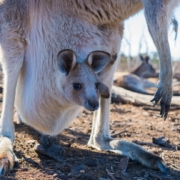Microbiota from a surprising source—baby kangaroos—might decrease cattle methane production
By Prof. Seppo Salminen, University of Turku, Finland
One of the major contributors to greenhouse gas production is the final stage of anaerobic fermentation in the rumen (pre-stomach compartment) of cattle, which produces methane. The process is the top agricultural source of greenhouse gases worldwide. In addition, the formation of methane is associated with approximately 10% energy loss in animals.
To ameliorate the drawbacks of methanogenesis, scientists at Washington State University explored the potential of homoacetogenic microbes (i.e. those that promote the production of acetate), and especially Acetobacterium woodii, to outcompete methanogens and thereby reduce methane production in the rumen of production animals.
For this purpose, original inoculum of rumen samples were obtained from freshly slaughtered cows and developed into stable consortia of methanogens. Meanwhile, homoacetogenic cultures were developed from baby kangaroo droppings obtained from a wallaby ranch in Washington State. The original baby kangaroo sample had no methanogens present. Rumen bioreactors were inoculated with the bovine study samples and kangaroo gut microbes, and monitored for methane production and kinetics.
The investigators reported that acetogens are dominant in kangaroos, and in their presence methanogens are generally inhibited. The researchers suggested that kangaroos have interesting novel acetogens that utilize hydrogen, which rumen fermentation produces. These acetogens are potential probiotics, once they are well characterized and the benefits to rumen fermentation are documented.
This study also suggests that a variety of kangaroo acetogens should be further explored for their potential use in controlling rumen fermentation and reduction of greenhouse gas production. At the same time, additional benefits of acetogens from other marsupials could be explored and new findings are possible for potential biotic (pro-, pre-, syn- and postbiotic) development.





